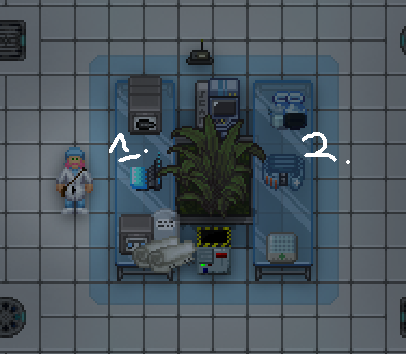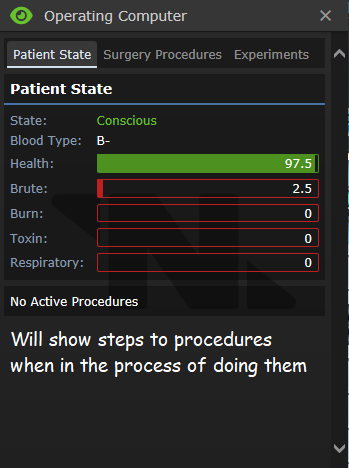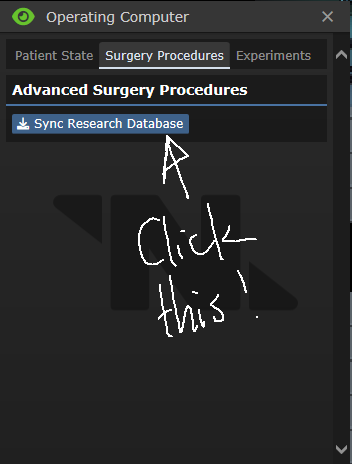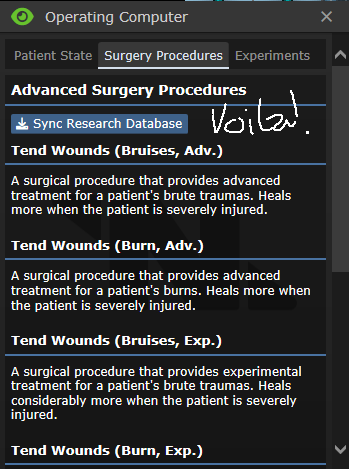Hi, mibmob here!
I’ve frequented Medical Doctor enough to think myself qualified to make a guide to anyone who’s willing to learn the in’s and out’s of healing your fellow crewmates. Since Fulpstation uses /tg/station’s code, I advise you use the Surgery wikipedia page - but I’ll try to crunch all this info into a guide that even an intern can consume!!
The basics
You’re equipped with a surgical medkit at your initial arrival to the station, which includes various meds and some basic surgical tools.
First row, from left to right:
Drapes - You use these to select which surgery you’ll be doing on the patient. Keep in mind you can only do surgery on exposed body parts, so often times you’ll need to click + drag the person onto yourself to bring up the menu and take their clothes off.
Scalpel - The starting point of every surgery, you use this to make the first incision when operating on a patient. Be sure to have combat mode turned off, and that you’ve started surgery with drapes beforehand, otherwise you’ll end up cutting them accidentally.
Hemostat - A tool that helps close up wounds, stitch up bruises and burns alike and plug up burst blood vessels, you’ll be using this a lot to tend wounds as this is often used as the step after making incisions in surgery.
Cautery - You’ll be using this to finish up your surgeries (at least, most that require it) or cauter deep cuts that go further than skin deep.
(Ignore the item next to it)
Second row, from left to right:
Health Analyser - This item helps to identify serious wounds in a patient, and tells you what types of damage someone has taken. The different types of damage are brute, burn, toxin and suffocation which are caused by different attacks, substances and the like - however, we can worry about them later.
Medical gauze - Starting with a pack of 12 of these in your medkit, these can be used to wrap heavy burns or broken limbs to aid in their healing process. You can also bandage cuts to help them heal easier, however gauzes on their own do not heal types of damage directly.
Sutres - These meds will heal brute damage when applied to a limb, but are finite and have limited uses. You can use these when in a pinch and you have no time to do surgery on a slightly-less-than-full-health clown that got bopped by a stray glass bottle in the bar.
Regenerative Mesh - Or regen mesh for short, these can be applied to a limb to heal burn damage, and can also be used to heal second or third degree burns. However in the case of third degree burns, you may also need to resort to performing surgery on the limb that has third degree burns: mesh can only do so much to heal.
Epinepherine Medipen - An epipen which will bring your fellow crewmates out of a critical state (critical meaning they are unable to get up and walk, and are often choking), which is good for saving them when they’re about to bleed out.
Arriving at Medbay
When you first arrive at Medbay for the first time there’ll be a lot of things you need to take into consideration, but the first things you should pay attention to are these things:
1. Medical HUD’s, which are equipped in your  eyes slot. These give you a small indicator on how healthy a person is, whether they have a disease or not, and how close they are to dying (often indicated by their icon
eyes slot. These give you a small indicator on how healthy a person is, whether they have a disease or not, and how close they are to dying (often indicated by their icon ![]() flashing red rapidly) and are generally a useful accessory to medical personnel across the department.
flashing red rapidly) and are generally a useful accessory to medical personnel across the department.
2. Medical belts, which aren’t essential as your surgical medkit works fine, but are useful as your roster of tools will quickly grow when figuring out what to use and when. They go in your  belt slot, and can store a maximum of 7 medical tools.
belt slot, and can store a maximum of 7 medical tools.
3. Defibrilator, which will bring a deceased patient back to life when wielded with two hands and applying to the chest of the patient. However, if the patient has too much damage of either burn or brute, or if their heart is heavily damaged then the defibs will report that tissue damage was too severe, or heart damage was too severe. In order to ensure your patient lives longer after a successful defibrilation, you should also ideally check their blood levels with your health analyser, and make sure to note what type they are - in the medbay cold areas you can find a blood pack crate which contains various types of blood that you can administer via an IV drip to help their survival, however make sure to disconnect the IV drip once you are done (usually a patient will need around 75% blood level to survive without suffocation damage). Other states that the patient can be in, such as a “grotesque husk” will require you to restore it to a valid state (revivable) in order to bring them back to life - in which case you need to ask your fellow chemists to make Synthflesh, a chem that can restore a body to valid status for revival. You can also buy synthflesh spray from the NanoDrug vendors in medbay, albeit pricey - but if you don’t know how to make synthflesh, or there are no chemists around then this is a good alternative.
4. Stasis bed, a bed which will allow you to do surgery on someone whilst preventing any further damage to come to the patient through toxin damage or suffocation damage that could be caused by chemicals - however, this also prevents you from using chemicals to heal types of damage since it’s prevented via stasis. This also includes blood transfusions (correct me if wrong), in which you’ll need to click the bed itself if a patient is on it to unbuckle them from stasis, administer the chems and then put them back on stasis. Keep in mind these can only be used when powered, and if you run out of power in medbay these will eventually power down.
5. Operating table, which although doesn’t prevent dead bodies’ organs from decaying via stasis, will be much faster to perform surgeries on than if you did so on stasis. You also get access to better surgery options when using a table that’s connected to an operating computer (6.) that has the surgeries researched.
6. Operating computer, which not only gives you a step-by-step guide to the current surgery you’re performing on, but also provides a connection to the research database which, once you bug science enough, can be updated with better surgeries that not only improve the speed at which you do things such as tend wounds, but also do things such as repairing previously non-functional organs (which can be pointed out through your health analyser).
In the thick of surgery
Your main job is to be healing people, providing aid and help to those badly hurt who just so happen to stumble into medbay. If you see someone’s healthbar even a teensy bit less green than it should be,  analyse them and diagnose their damage. Often you’ll be finding yourself doing Tend Wounds (burn/bruises) on people to patch their wounds up, but other surgeries may be required to help the crew in a jiffy. One of the most common surgeries done besides tend wounds is organ manipulation, often performed on the chest and is a way to remove organs and replace them with ease. This can be done to replace non-functional organs you have already fixed via surgery, however keep in mind that you should be quick to replace them if the patient is still alive - and if your patient is dead, keep track of how much damage the organic organs take so you can alternate between using stasis beds and surgery tables. Or you can just replace all their organs with cybernetic ones, however the lower the tier the more susceptible they are to EMP’s so keep bugging science to research better cybernetics for your patients. Do keep in mind that even though you can get cybernetics researched, there will be a point where you don’t have enough materials to make prosthetic organs, so asking science to research advanced biotechnology will give you access to machine boards for limb regrowers (which use synthflesh, and can make different species’ limbs) and organ harvesters, saving the need for making prosthetics all the time. You can also utilise the smart organ storage commonly found in the Morgue and if science has researched tier 4 parts you can upgrade it so that it not only preserves organs but also heals their damage too, without you having to perform surgery on them as you put the organs in.
analyse them and diagnose their damage. Often you’ll be finding yourself doing Tend Wounds (burn/bruises) on people to patch their wounds up, but other surgeries may be required to help the crew in a jiffy. One of the most common surgeries done besides tend wounds is organ manipulation, often performed on the chest and is a way to remove organs and replace them with ease. This can be done to replace non-functional organs you have already fixed via surgery, however keep in mind that you should be quick to replace them if the patient is still alive - and if your patient is dead, keep track of how much damage the organic organs take so you can alternate between using stasis beds and surgery tables. Or you can just replace all their organs with cybernetic ones, however the lower the tier the more susceptible they are to EMP’s so keep bugging science to research better cybernetics for your patients. Do keep in mind that even though you can get cybernetics researched, there will be a point where you don’t have enough materials to make prosthetic organs, so asking science to research advanced biotechnology will give you access to machine boards for limb regrowers (which use synthflesh, and can make different species’ limbs) and organ harvesters, saving the need for making prosthetics all the time. You can also utilise the smart organ storage commonly found in the Morgue and if science has researched tier 4 parts you can upgrade it so that it not only preserves organs but also heals their damage too, without you having to perform surgery on them as you put the organs in.
What’s your damage?
I mentioned earlier the different types of damage your patient can suffer from - but never explicitly stated what they are, and how you can fix them.
So, here are the different types:
Brute - Caused by taking physical attacks such as being punched, and can often be fixed by using sutres on someone or tending to their wounds via selecting Tend Wounds, Bruises. Sustaining enough brute damage by getting into fights and being punched can result in more major wounds like bone dislocation and fractures. Most often inflicted by chefs doing CQC on any intruders.
Burn - Caused by being burnt, either by being set on fire for prolonged amounts of time or being hit directly with a fire source e.g a welding tool, an Ethereal punch (as they do burn damage instead of brute when punching) or a shoddy lighter. Sustaining enough burn damage can result in getting second or third degree burns - both are bad, but if you allow a second degree burn to stay for long enough it can progress to a third degree, which will eventually infect the limbs that’s sustaining the burns. You can fix burn damage by doing Tend Wounds, Burn or by using regenerative mesh. Keep in mind you should ideally fix up all the burn wounds someone has before using regenerative mesh to fix up second/third degree burns, and if it ever gets to the stage of infection then you should debride burnt flesh, or excise infected flesh.
Toxin - Caused by ingesting any type of chemical that deals toxin damage, primarily alcohol which causes this. You can either use the toxin treatment kits you get at medbay or use multiver, which will purge the body of chemicals that are in the patient’s bloodstream, alongside healing toxin damage. You can also do blood filter to fix this, but will take a bit longer than injecting chems and sending your patient on their way.
Suffocation - Caused by either being choked, low blood, not enough oxygen in the patient’s system or other foreign gases are in the air. You can fix this by CPR’ing someone, giving them more blood or giving them meds from the oxygen deprivation treatment kit in medbay such as convermol or iron pills.
Tools, part two
So, we talked about the different types of surgery in the sections prior, but how do we get around to doing them? The starter tools you get in your medkit are only the basics, and once you find more serious wounds you’ll need to print different tools from your department’s protolathe.

Part 2 includes:
Circular Saw  - Often used to saw through bone, if you’re operating on the head or the chest, you’ll be using this to cut through and access those tender, juicy organs your patient’s holding. Keep in mind this does a fair amount of brute damage, and can possibly crit or kill your patient - but once you cauter and finish the surgery, the brute damage will be healed for the most part.
- Often used to saw through bone, if you’re operating on the head or the chest, you’ll be using this to cut through and access those tender, juicy organs your patient’s holding. Keep in mind this does a fair amount of brute damage, and can possibly crit or kill your patient - but once you cauter and finish the surgery, the brute damage will be healed for the most part.
Bonesetter - This tool can be used directly on a dislocated limb to fix it back into place, causing brute damage, or you can use it in surgery when repairing hairline or compound fractures to fix broken bones. Compound fractures require bone gel and surgical tape to be fully fixed, whilst hairline fractures require only an incision and the use of the bonesetter to fix.
- This tool can be used directly on a dislocated limb to fix it back into place, causing brute damage, or you can use it in surgery when repairing hairline or compound fractures to fix broken bones. Compound fractures require bone gel and surgical tape to be fully fixed, whilst hairline fractures require only an incision and the use of the bonesetter to fix.
Retractors  - These retract the skin of a patient and are arguably just as important as hemostats during surgery, being one of the first things you need to use on your subject before proceeding with the other steps of surgery (using this is most common in organ manipulation and if you’re not sure what step to do next, it’s probably retractors)
- These retract the skin of a patient and are arguably just as important as hemostats during surgery, being one of the first things you need to use on your subject before proceeding with the other steps of surgery (using this is most common in organ manipulation and if you’re not sure what step to do next, it’s probably retractors)
Blood filter - The last of these tools, it’s something you’ll likely use the least unless you have a drunkard come into medbay begging for you to fix their liver. Blood filter is used in the Filter Blood surgery, sieving out all chemicals present within the subject’s blood regardless of whether it’s good or not.
- The last of these tools, it’s something you’ll likely use the least unless you have a drunkard come into medbay begging for you to fix their liver. Blood filter is used in the Filter Blood surgery, sieving out all chemicals present within the subject’s blood regardless of whether it’s good or not.
Crummy, crummy science and your boss
As much as I like to rag on the science department, they’re going to be the department you rely on the most for things such as researching better surgery or researching better organs. In return, try your best to comply with them and give them what they need - they’re essential for running an efficient medbay. However, most of your concerns will likely be covered by the Chief Medical Officer (which I might make a guide for later) and if you need any help regarding medical, ask them. They’re the Head of your department and will have much more experience handling any burning questions you have about medical. Furthermore, the mentorhelp option is always available to ask about certain mechanics if you still need help understanding the game more.
Conclusion and tips
Hopefully this guide was helpful in understanding what you’ll come across as a MD in SS13, and I’d appreciate if you have any other questions regarding medical that I should answer or include in this guide - most of the stuff needed to learn medical doctor will come naturally over time, and you’ll become better only with time and experience. Don’t be afraid to mess up! It’s part of the experience!
Also, some med tips:
- Aggressively grabbing someone in combat mode, then clicking on an operating table will lay them on it instantly
- You can adjust some jumpsuits to have its top half lowered so you can operate on the chest, however this doesn’t include the legs
- You can scan the chemicals that someone has in their system by right clicking with a health scanner, useful for seeing whether someone is drunk or has gotten stung by a bunch of toxic bees - furthermore you can also check what someone’s allergic to if they have the trait - make yourself double-sure to check this first before administering chemicals to aid them (cough cough, Timmy Two-Toes)
- You can defibrilate someone mid-surgery as long as their brute or burn damage is below 160 and their heart has been repaired sufficiently, but it’s best to fix them up below that threshold so they can survive longer after a successful defib
- A reminder that chemicals will NOT work on stasis beds!! People can easily forget this sometimes
- Different species have different bloodtypes and organs you need to keep an eye out for, for example lizards need L blood, and etherals need LE blood. Flypeople and ethereals will generally have much different organs but can still be replaced with normal cybernetics - you just need to eyeball it and it will work just fine.
- You can fireman carry someone by aggressive grabbing someone and then dragging them onto you - this will take up a hand slot so be sure to have a hand free for this
- If you find any foreign organs or if you get implants researched, shift-click to inspect them to see where it should be placed in
- Inspecting someone will show whether they can be revived or not, if the suffix “..and their soul has departed” is next to “they are limp and lifeless” then they will be catatonic if you choose to revive them A.K.A non-sentient. Other minor details, like “they have pale skin” can show you that your patient is anemic and has low blood levels. Meanwhile, something like “they have a stupid expression on their face” are signs of brain damage, and etc.
- If you have a numpad on your keyboard you can use it to target limbs before using drapes (or whilst using drapes) as a quicker way to do so rather than having to click each time,
Num7 is eyes, Num8 is the head, Num9 is the mouth, Num4 is the right arm, Num5 is the chest, Num6 is the left arm, Num1 is the right leg, Num2 is the groin and Num3 is the left leg.
(will add more tips when I think of some)





